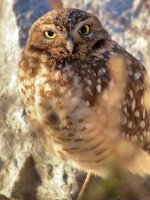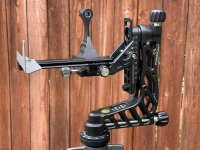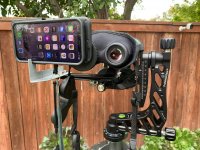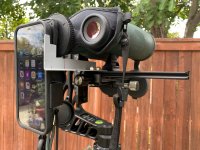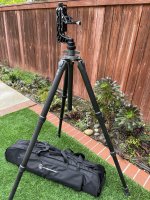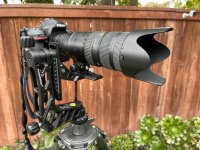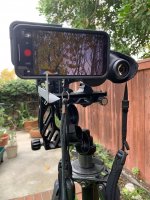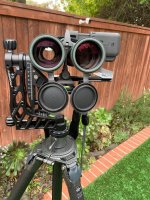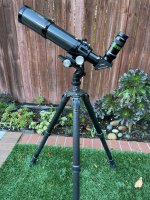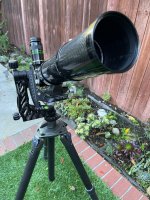Spectrum805
Member
I am a photographer (full frame DSLR) and amateur astronomer who has good telescopes (101mm and 80mm APO reflectors) and binoculars (15x56) for stargazing, recently developed an interest in bird watching and terrestrial viewing. I want to optimize my equipment for versatile uses, quickly got confused and bogged down by a overwhelming variety of choices on tripod heads. Perhaps someone who have gone through this process can share their experience?
1) My equipment weights from 4Lbs (either the 15x56 bino or DSLR with a light lens, not both) to 20Lbs (101mm APO telescope with accessories), I already concluded there is no way a ballhead will work (I have Arco Swiss Z1 ball that can handle 50+Lbs, but the whole assembly will crash if I loosen the ball for repointing. I also concluded 3-way tilt heads are too slow and cumbersome for birding. Because a heavy-duty pan-tilt video head tends to be very large and heavy, still has the crashing concern as ball heads, and I am not that much into videography which requires ultra-smooth motion, I think a photographic gimbal heads would best suits my needs, but here is where my confusion starts.
2) There are Swarovski PTH and Gitzo GHFG1 gimbal fluid heads (clone of each other) designed specifically for birding scopes. But the distance from the quick-release plate center to the vertical rail surface visually is much smaller than the 3" clearance to mount my Swarovski SLC 15-56 binos mounted on the Ta-SLC tripod adapter. So these two are out of the consideration.
3) There are many other gimbal heads that are laterally larger, do satisfy the 3" clearance cited above. One of the choices I am considering is ProMediaGear GK Jr Katana Pro gimbal head which only weighs 2.4 Lbs but can handle 50Lbs. However, for this (and other) photographic gimbals, I can only find reviews on how they are used to handle heavy photographic lenses and cameras for wild life photograph. Are there people use them for bird watching using tripod mounted (relatively) big binos and spotting scopes? Would the relatively short length of binoculars make lateral scan of the terrestrial scenery jittery?
4) An even bigger question is mounting telescope on photographic gimbals. Can I get away with not buying a dedicated Alt Az mount for telescope, but using a heavy-duty photographic gimbal head instead? I just don't like the idea of carrier a Alt Az for telescope, a gimbal for heavy-lens, and a ballhead for photography. Carrying three heads on the road is just too much. What capability am I missing by just a single heavy-duty gimbal head? I thought I can make an adapter to transit from Arca Swiss to Vixen/Losmandy dual clamp to hold a telescope. Since in a gimbal cradle there is no need to do side-mount of heavy equipment which will stress up the more narrower Arca Swiss slots, maybe it is OK? Why am I not seeing anyone talking about mounting 3" to 4" refractor telescope on photographic gimbal mount? What consideration am I missing?
5) There are several reasons I am resisting getting a big and good spotting scope: a) A good spotting scope comparable to my APO telescope will be in the $5K range. b) It will NEVER match the 100 degree apparent field-of-view of Ethos eyepieces that I already have for by telescopes. For example, Swarovski 95mm at 30x has a true field of view of ~1.9 degrees, through my telescope at 32x (with a 17mm eyepiece) I am getting ~3.1 degrees sharp to the edge. The viewing area is 2.7x bigger even at a slightly larger magnification! c) I just don't like carrying so much equipment on the road. What am I missing? How does other people think about using astronomical telescope in place of spotting scope for terrestrial viewing and (stationary, near my parked car on the road side, or walking up to 100 yards from the car).
6) Back to the original question, is there a single tripod head, especially a heavy-duty gimbals (up to 5Lb is OK if I can get away with only one), that can be used to satisfy the varied needs (a) Terrestrial viewing using a 3" to 4" refractor telescope (8Lbs to 20Lbs), in lieu of a spotting scope, on a heavy tripod near my car (b) Birdwatch with 15x56 binocular on a travel tripod for hiking up to a couple of miles (c) Used as a regular ball-head equivalent for landscaping and travel photography? (d) If eventually I do get a spotting scope for bird watching, be compatible with digiscoping as well. Or pointing out my thinking is all wrong, these requirements can not be reconciled in one gimbal head. As I stated earlier, one of the options I am considering is ProMediaGear GK Jr Katana Pro gimbal head which only weighs 2.4 Lbs but can handle 50Lbs equipment.
Thanks!
Haibo
1) My equipment weights from 4Lbs (either the 15x56 bino or DSLR with a light lens, not both) to 20Lbs (101mm APO telescope with accessories), I already concluded there is no way a ballhead will work (I have Arco Swiss Z1 ball that can handle 50+Lbs, but the whole assembly will crash if I loosen the ball for repointing. I also concluded 3-way tilt heads are too slow and cumbersome for birding. Because a heavy-duty pan-tilt video head tends to be very large and heavy, still has the crashing concern as ball heads, and I am not that much into videography which requires ultra-smooth motion, I think a photographic gimbal heads would best suits my needs, but here is where my confusion starts.
2) There are Swarovski PTH and Gitzo GHFG1 gimbal fluid heads (clone of each other) designed specifically for birding scopes. But the distance from the quick-release plate center to the vertical rail surface visually is much smaller than the 3" clearance to mount my Swarovski SLC 15-56 binos mounted on the Ta-SLC tripod adapter. So these two are out of the consideration.
3) There are many other gimbal heads that are laterally larger, do satisfy the 3" clearance cited above. One of the choices I am considering is ProMediaGear GK Jr Katana Pro gimbal head which only weighs 2.4 Lbs but can handle 50Lbs. However, for this (and other) photographic gimbals, I can only find reviews on how they are used to handle heavy photographic lenses and cameras for wild life photograph. Are there people use them for bird watching using tripod mounted (relatively) big binos and spotting scopes? Would the relatively short length of binoculars make lateral scan of the terrestrial scenery jittery?
4) An even bigger question is mounting telescope on photographic gimbals. Can I get away with not buying a dedicated Alt Az mount for telescope, but using a heavy-duty photographic gimbal head instead? I just don't like the idea of carrier a Alt Az for telescope, a gimbal for heavy-lens, and a ballhead for photography. Carrying three heads on the road is just too much. What capability am I missing by just a single heavy-duty gimbal head? I thought I can make an adapter to transit from Arca Swiss to Vixen/Losmandy dual clamp to hold a telescope. Since in a gimbal cradle there is no need to do side-mount of heavy equipment which will stress up the more narrower Arca Swiss slots, maybe it is OK? Why am I not seeing anyone talking about mounting 3" to 4" refractor telescope on photographic gimbal mount? What consideration am I missing?
5) There are several reasons I am resisting getting a big and good spotting scope: a) A good spotting scope comparable to my APO telescope will be in the $5K range. b) It will NEVER match the 100 degree apparent field-of-view of Ethos eyepieces that I already have for by telescopes. For example, Swarovski 95mm at 30x has a true field of view of ~1.9 degrees, through my telescope at 32x (with a 17mm eyepiece) I am getting ~3.1 degrees sharp to the edge. The viewing area is 2.7x bigger even at a slightly larger magnification! c) I just don't like carrying so much equipment on the road. What am I missing? How does other people think about using astronomical telescope in place of spotting scope for terrestrial viewing and (stationary, near my parked car on the road side, or walking up to 100 yards from the car).
6) Back to the original question, is there a single tripod head, especially a heavy-duty gimbals (up to 5Lb is OK if I can get away with only one), that can be used to satisfy the varied needs (a) Terrestrial viewing using a 3" to 4" refractor telescope (8Lbs to 20Lbs), in lieu of a spotting scope, on a heavy tripod near my car (b) Birdwatch with 15x56 binocular on a travel tripod for hiking up to a couple of miles (c) Used as a regular ball-head equivalent for landscaping and travel photography? (d) If eventually I do get a spotting scope for bird watching, be compatible with digiscoping as well. Or pointing out my thinking is all wrong, these requirements can not be reconciled in one gimbal head. As I stated earlier, one of the options I am considering is ProMediaGear GK Jr Katana Pro gimbal head which only weighs 2.4 Lbs but can handle 50Lbs equipment.
Thanks!
Haibo





